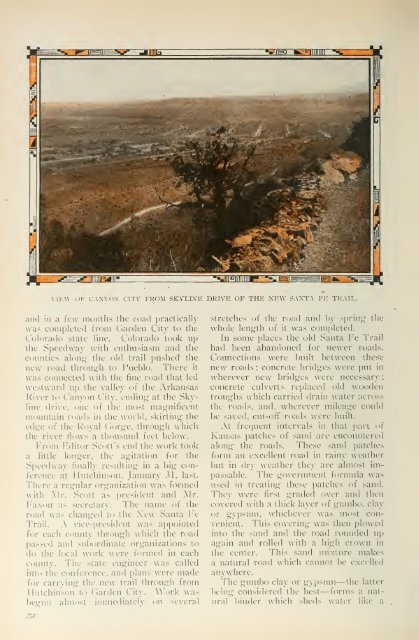Create successful ePaper yourself
Turn your PDF publications into a flip-book with our unique Google optimized e-Paper software.
\ ii:\v oi- c:.\.\^"()\' c\r\ from skvlixe drive of T[^K new sax'I'a fk tk.ml.<br />
^^-^•^s^K<br />
and in a few monlhs the road practicall}'<br />
was completed from Garden City to the<br />
C\)lorado state line. Colorado took ii])<br />
the Speedway with enthusiasm and the<br />
counties along- the. old trail pushed the<br />
new road through to Puehlo. There it<br />
was connected with the fine road that led<br />
westward up the valley of the Arkansas<br />
River to Canyon City, ending at the Skyline<br />
drive, one of the most magnificent<br />
mountain roads in the world, skirting the<br />
ci\ge of the Royal Gorge, through which<br />
the river flows a thousand feet below.<br />
I'>om Editor Scott's end the work took<br />
a little longer, the agitation for the<br />
Si)eedway finallx resulting in a big conference<br />
at llutchinson, January 31, last.<br />
There a regular organization was formed<br />
witli Mr. Scott as president and Mr.<br />
I'"a.\(in- as secretary. The name oi the<br />
road was changed to tlie Xew Santa l'\'<br />
Trail. A vice-i)residcnt was appointed<br />
for each county through whicli the road<br />
passed and subordinate organizations to<br />
do the local work were formed in each<br />
county. The state engineer was called<br />
into the conference, and j^lans were made<br />
for carrying the new trail through from<br />
Hutchinson to Garden City. Work was<br />
begun almost immediately on several<br />
stretches of the road and by spring the<br />
whole length of it was com])leted.<br />
In some places the old Santa Fe Trail<br />
had been abandoned for newer roads.<br />
Connections were built between thes'e<br />
new roads ; concrete bridges were put in<br />
wherever new bridges were necessary<br />
concrete culverts re])laced old wooden<br />
troughs which carried drain water across<br />
the roads, and, wherever mileage could<br />
be saved, cut-off roads were built.<br />
At frequent intervals in that i)art of<br />
Kansas patches of sand are encountered<br />
along the roads. These sand patches<br />
form an excellent road in rainy weather<br />
but in dry weather they are almost im-<br />
])assable. The government formula was<br />
used in treating these ])atches of sand.<br />
They were first graded over and then<br />
covered with a thick layer of gumbo, clay<br />
or gypsum, whichever was most convenient.<br />
This covering was then plowed<br />
into the sand and the road rounded up<br />
again and rolled with a high crown in<br />
the center. This sand mixture makes<br />
a natural ro.nd which cannot be excelled<br />
anywhere.<br />
The gumbo clay or gypsum—the latter<br />
being considered the best—forms a natural<br />
binder which sheds water like a<br />
274
















